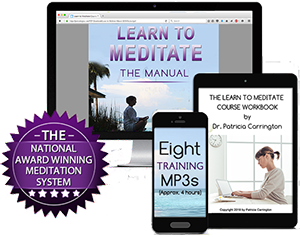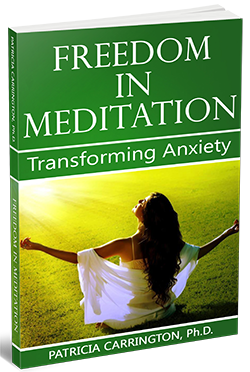 Handling Tension-Release Side Effects during Meditation
Handling Tension-Release Side Effects during Meditation
Fortunately, enough is now known from our practical work with meditation to enable us to begin to offer considerable guidance to meditators who are experiencing temporary discomforts. The first step in the management of tension-release is to become aware of the ‘initial adjustment period’, an interim period which lasts for roughly the first two to three weeks after beginning meditation. Its exact duration depends on the personality of the meditator and the life-pressure she has recently had to face.
Too rapid unwinding can take place in certain people when they first learn to meditate because the changeover from a consistently tense state to a relaxed state is too sudden to be assimilated. The switch to a more peaceful state can be a mixed blessing if the contrast brings with it a discomforting release of tension.
In such instances, temporary side-effects may spill over and affect the daily life of the meditator, and signs of tension release, perhaps tears or feelings of anger, may occur between meditation sessions. When this happens it is an indication that some backlog of tension and emotional stress is being released before a better emotional balance is achieved through meditation. Almost always these somewhat inconvenient side-effects disappear when meditation becomes established.
A problem that occasionally arises during the adjustment period occurs when a person is very tired, having been deprived of sleep or rest for a considerable length of time before learning to meditate, or has been overworked or especially tense, the chances are that commencing meditation may lead to a temporary state of ‘making up for lost time’. At this point, the need to rest may be so strong that the person has a sense of becoming inefficient.
Usually the condition clears up on its own after a few weeks without the meditator having to do anything about it, but sometimes it may require adjustment of meditation time or even temporary suspension of meditation. In Chapter 1 of Freedom in Meditation, in which I describe my experiences on first learning to meditate, I discuss an example of this from my life.
Practically speaking, the best way to handle extra-rapid stress-release is to radically reduce the amount of meditation time and do so without delay. Whenever we made such a time adjustment with a trainee, almost without exception it has proved to be helpful. Meditating for shortened periods of time under such conditions, or perhaps only once a day, usually changes meditation back into a thoroughly satisfactory experience.
Reducing Meditation Time
In teaching Clinically Standardized Meditation (CSM) we frequently reduce a trainee’s meditation time from twenty minutes to ten minutes and sometimes to five minutes or less when this is necessary. We even reduce the time after the very first session, if the person has experienced some severe discomfort during meditation. This reduction is undertaken as quickly as possible without waiting to see if the strong side-effects go away on their own.
If experiencing unpleasant tension-release is allowed to go on too long, the individual will often quit meditation and refuse to go back to it later on. This situation can almost invariably be avoided if the adjustment is made rapidly. This will enable the person to reinstate longer meditation times later on, increasing the time little by little, until the meditator discovers a time period that is satisfactory for a permanent meditation schedule.
If we need to assign a meditation time under five minutes, we sometimes suggest that the person practice these shortened meditation periods more frequently, perhaps five or six times a day, although it is unusual to have to reduce the time by this much. Most people show only mild, easily manageable tension release effects, even when commencing meditation.
Fortunately most of us have a built-in safety mechanism. Most people do not continue to do things that are causing them discomfort or that may threaten their emotional adjustment. This tendency usually acts as a brake to prevent more serious difficulties arising from tension-release. Occasionally a person will fail to listen to the wisdom of his own inner self and remain rigidly with a fifteen- or twenty-minute twice-daily schedule in the face of mounting side-effects which are not responding to this regime. This can cause a number of complications which we would consider.
It is precisely at this point that a meditator should feel free to skip meditations if this feels right, cut back to once a day or once every other day, or temporarily stop meditating altogether – whichever maneuver corrects the situation. Each meditator must learn to listen to his own inner wisdom as to what duration is best for him under such circumstances.
Some of the useful effects of cutting down meditation time are illustrated by a friend of mine, an extremely competent administrator handling a position of considerable responsibility, to whom I had taught CSM. She experienced a very fulfilling first meditation, but within two days she was complaining that her meditations were leaving her ‘too vulnerable’. On one occasion when she was interrupted by the sound of the telephone, she was so startled that she found herself nauseous and trembling afterward and phoned me to ask what to do. I suggested that she return to her room, to be sure to silence the phone, and continue meditating for another fifteen minutes. This was to help her ‘take the charge off’ the disturbing interruptions, and in fact it did so. Her anxiety and nausea disappeared and she once more felt tranquil.
Two days later, however, she reported that meditation was causing her to lose efficiency in a distressing manner. While she felt comfortable and unusually rested during the day, she was making ‘lazy errors’ in her work, something uncharacteristic of her. She found herself taking twice as long to accomplish certain administrative tasks, which would ordinarily be simple for her to do.
When we talked this over, we both had the impression that while letting up a bit from her regular pace might be a good idea for her in the long run, during the initial ‘adjustment period’ it seemed to be taking too extreme a form. Since she felt it was genuinely interfering with her work, she had begun to resist doing her meditations. I suggested that she cut her meditation time down to ten minutes twice daily. When she did this, her inefficiency cleared up. She was no longer slowed down to a point where she could not work and she continued to derive relaxation from meditation.
This anecdote exemplifies the fact that it is important for anyone practicing the simple Westernized forms of meditation to realize that no time interval is necessarily ‘correct’ for these techniques. Twenty-minute sessions, for example, are simply one possibility. In the recorded training of CSM we begin with only ten minutes of meditating and have the person gradually increase their meditation time over the next few weeks until they reach twenty minutes. This has proven to be a very safe and satisfactory procedure for those learning the method at home without direct supervision.
Related Product:
Learn to Meditate Course
Clinically Standardized Meditation (CSM) has been used by individuals, medical institutions, and organizations, worldwide. The main advantages of CSM (and also its difference to other meditation techniques) are its simplicity, its flexibility and its sensitivity to the individual intentions and inclinations of those who learn it. CSM is extremely permissive, which makes it easier to personalize and internalize its experience.
Patricia Carrington, Ph.D. is the author of the classic “Freedom in Meditation”







